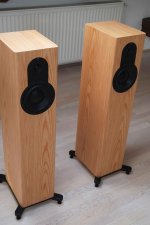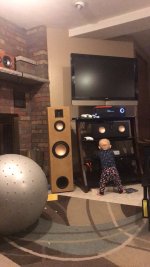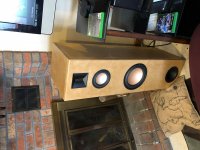Hey, boet! While you are reseaching, do also look into waveguides for extending LF response of ca 1" tweeters, which should make it easier to cross over to those metal cone drivers.
Awesome thanks, ive decided on these because of their performance and responses etc:
Peerless by Tymphany BC25TG15-04 1" Silk Dome Tweeter
D6.8 in a 0.8 cuft vented box tuned to ~ 34Hz with some response shaping, crossed at 2 kHz to a decent tweeter (like the SB26ADC). The result is rather spectacular, serious low end with very clean uncoloured sound throughout the rest of the spectrum. Only drawback is sensitivity (84 dB), but still quite easy to drive. They can handle some serious power with very low distortion...
Attachments
Last edited:
Old thread but I will chime in. The M8N is an great woofer/subwoofer. It's best crossed at 500 hz or lower. Once it starts to enter break up it sounds thin and shrill. One or two as part of a three way would be great. The cone is fairly heavy and benefits from a solid cabinet.
I built a 2 way with the M8N with the intention of equalizng it flat and going up to 1800 hz to cross to a tweeter. It sounds shrill and unnatural up top, and equalization only helps some. The build quality is fine btw, very sturdy. They would work well in a car.
I built a 2 way with the M8N with the intention of equalizng it flat and going up to 1800 hz to cross to a tweeter. It sounds shrill and unnatural up top, and equalization only helps some. The build quality is fine btw, very sturdy. They would work well in a car.
Last edited:
After building a few decent two-way speakers I wanted to try building a 3-way crossover speaker. Turns out a 3-way crossover is exponentially more difficult than a 2-way...
I am using M8N, M5N and a Beston RT002A Ribbon Tweeter. The 3-way crossover is currently being removed and I will go with an active two-way crossover with a passive on the M5N and ribbon.
Does anyone have recommendations for the two-way crossover for the M5N and ribbon tweeter? I have been using 2-Way Crossover Calculator / Designer for my crossovers with decent results but I am sure there is room for improvement.
I am using M8N, M5N and a Beston RT002A Ribbon Tweeter. The 3-way crossover is currently being removed and I will go with an active two-way crossover with a passive on the M5N and ribbon.
Does anyone have recommendations for the two-way crossover for the M5N and ribbon tweeter? I have been using 2-Way Crossover Calculator / Designer for my crossovers with decent results but I am sure there is room for improvement.
Attachments
Yes- calculators are not good xover designers, unless you do ALL of the math it entails.
Honestly, I don't think your mid and tweeter choice are going to meld all that well. The mid really shouldn't go much above 2.5kHz due to the breakup, and the RT002A should not go below about 3kHz. (This is the closed-back planar, right?)
I've used the M5N to 2.6kHz, but the network was 4th order electrical to kill the breakup. The M8N I've also used, and it needs care to kill the +15dB breakup at 1kHz as well- even if you xover low.
You should use a xover modeler software with manufacturer plots modeled to your baffle and box response, and then see where you can go.
Later,
Wolf
Honestly, I don't think your mid and tweeter choice are going to meld all that well. The mid really shouldn't go much above 2.5kHz due to the breakup, and the RT002A should not go below about 3kHz. (This is the closed-back planar, right?)
I've used the M5N to 2.6kHz, but the network was 4th order electrical to kill the breakup. The M8N I've also used, and it needs care to kill the +15dB breakup at 1kHz as well- even if you xover low.
You should use a xover modeler software with manufacturer plots modeled to your baffle and box response, and then see where you can go.
Later,
Wolf
Yes it’s the closed back planar, and the data sheet says to cross at greater than 2.5kHz with third order to allow for 40 watt continuous usage. There’s no way I’ll run it close to 40 watts so I’m fine with crossing it at 2.5kHz. I believe I did 4th order at ~2.5 with the center MTM I built (with the same drivers) and it sounds decent; no measurements have been taken. I have downloaded Xsim but haven’t actually built anything based on it. What software would your recommend?
Here's my 2 cents. You took on an ambitious project and got the thing built and it looks decent. So that's good. I would hook up an active crossover to the ribbon and m5n, and just listen for a while. The ear doesn't lie IF you are patient.
The main issue is running that m5n up that high. The fact that it is directional enough to match the ribbon means you're running it well into break up. Whether or not you like the sound or not is a matter of taste. I personally hate metal cone break up.
Also crossing the ribbon too low can cause harmonic distortion issues which can sound unnatural. People usually use steeper slopes with ribbons for partly this reason.
If you decide you don't like the m5n I would try this. Get some flex seal from the hardware store and damp the back of the cone with it. If that doesn't work I would try another driver. Tymphany makes some poly cone drivers that can be run up high. Also something like a full range paper cone might be a good candidate to cross to the ribbon. You can probably find something that will fit in the hole without too much trouble.
Nothing wrong with using xsim or Dave Ralph's software to help design the passive crossover either.
The main issue is running that m5n up that high. The fact that it is directional enough to match the ribbon means you're running it well into break up. Whether or not you like the sound or not is a matter of taste. I personally hate metal cone break up.
Also crossing the ribbon too low can cause harmonic distortion issues which can sound unnatural. People usually use steeper slopes with ribbons for partly this reason.
If you decide you don't like the m5n I would try this. Get some flex seal from the hardware store and damp the back of the cone with it. If that doesn't work I would try another driver. Tymphany makes some poly cone drivers that can be run up high. Also something like a full range paper cone might be a good candidate to cross to the ribbon. You can probably find something that will fit in the hole without too much trouble.
Nothing wrong with using xsim or Dave Ralph's software to help design the passive crossover either.
Last edited:
Yes it’s the closed back planar, and the data sheet says to cross at greater than 2.5kHz with third order to allow for 40 watt continuous usage. There’s no way I’ll run it close to 40 watts so I’m fine with crossing it at 2.5kHz. I believe I did 4th order at ~2.5 with the center MTM I built (with the same drivers) and it sounds decent; no measurements have been taken. I have downloaded Xsim but haven’t actually built anything based on it. What software would your recommend?
The datasheet is talking about power handling not how well it will perform crossed that low. You won't blow it but you'll be well into increased distortion. You would do well to heed Wolf, he is speaking from experience here, both working with Hivi drivers and planars like you're using.
The proper way to design the crossover would be to measure the drivers in box, then simulate the crossover, taking into account distortion, off axis performance, etc. The closer you can get to that the better. Free software for measurement is available, REW and arta for a start. For crossover design, you have xsim, vituixcad, and PCD.
Thank you all for the helpful tips and insight. Those speakers were purchased before I even knew about the DIY audio forums and are indeed not the best match. The only reason I am not scrapping the project is because I already cut the second baffle and own the drives.
I didn't realize I would need to correct for the break ups with the M8N because I was crossing it low (~300 Hz) with ESP's Linkwitz-Riley Crossover active filter.
Knowing what I know now I probably should have purchased the HiVi DIY 3.1a kit instead of building from the ground up...
I had an interesting thought last night about the speaker last night: what if I cut out a hole in the rear of the cabinet for a second M5N to make it a pseudo bi-pole. The reason is that running two M5N in parallel helps increase the sensitivity to better match the ribbon. Although, just buying a better suited driver would probably be easier/better.
I didn't realize I would need to correct for the break ups with the M8N because I was crossing it low (~300 Hz) with ESP's Linkwitz-Riley Crossover active filter.
Knowing what I know now I probably should have purchased the HiVi DIY 3.1a kit instead of building from the ground up...
I had an interesting thought last night about the speaker last night: what if I cut out a hole in the rear of the cabinet for a second M5N to make it a pseudo bi-pole. The reason is that running two M5N in parallel helps increase the sensitivity to better match the ribbon. Although, just buying a better suited driver would probably be easier/better.
Thank you all for the helpful tips and insight. Those speakers were purchased before I even knew about the DIY audio forums and are indeed not the best match. The only reason I am not scrapping the project is because I already cut the second baffle and own the drives.
I didn't realize I would need to correct for the break ups with the M8N because I was crossing it low (~300 Hz) with ESP's Linkwitz-Riley Crossover active filter.
Knowing what I know now I probably should have purchased the HiVi DIY 3.1a kit instead of building from the ground up...
I had an interesting thought last night about the speaker last night: what if I cut out a hole in the rear of the cabinet for a second M5N to make it a pseudo bi-pole. The reason is that running two M5N in parallel helps increase the sensitivity to better match the ribbon. Although, just buying a better suited driver would probably be easier/better.
I wouldn't scrap it. Try to get the drivers to sing together. 200-300 hz for the m8n is good. You might be able to use a subwoofer output to another amp to drive the m8n.
It looks like from the picture you have it sitting near a tv and table. That position will completely dominate the sound. You can't tweak it in a spot like that. I wouldn't sit too close to it with that horn tweeter either.
Last edited:
I simulated the crossover from Sehlin Sound Solutions - Mercury with XSim and the response looks promising, much better than sims from the Swope HT crossover. Hopefully I will get them to play nice together.
- Status
- This old topic is closed. If you want to reopen this topic, contact a moderator using the "Report Post" button.
- Home
- Loudspeakers
- Multi-Way
- HIVI for DIY project?


